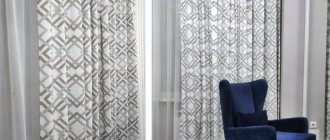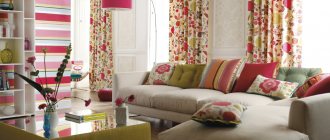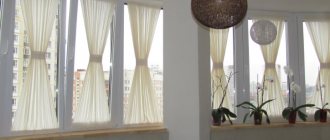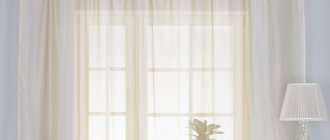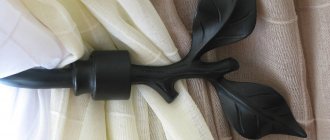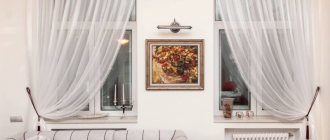A decorated window completes the image or sets the tone for the interior style of the room. Light and airy tulle plays an important role here, balancing even heavy curtains.
If you follow fashion, in Asia they prefer to close off rooms from prying eyes from the street, and in Europe they hang curtains without tulle.
What types of curtains are there?
The wide variety of draperies makes it difficult to choose how to install curtains. To make the right decision, you need to navigate their types:
- Sliding – straight, cafe, with lambrequins, photo curtains, muslin.
- Lifting - Roman blinds, Italian, French, roller blinds.
- Stationary – pleated curtains, stained glass.
- Doors - for decorating openings.
- Thread - natural woven fibers called muslin. Used in kitchens, living rooms, bedrooms.
The choice is great, and this contributes to the correct design of the interior of a house or apartment.
The art of drapery
Drapery - one-sided, counter or bow folds on the curtain. Few folds are made on thick tulle, and thin fabric is draped with frequent and narrow folds, and work done by hand lasts longer.
Using tiebacks, staples, rings, and sometimes thread, horizontal and vertical draperies of bizarre shapes are created.
Tip: when planning drapery, you will need to take fabric 1.5-3 times wider than the length of the cornice and purchase a special ribbon with loops in 2-3 rows.
To drape the bottom of a light curtain, the edge is raised in 1-3 places to the desired height and fastened to the canvas.
To create a classic wave, 1-2 sags are formed on the inner edge of the curtain.
More: Circuit breakers - what are they for?
If you intercept the middle of the curtain or the top and bottom, you will get an elegant “column” or “vase”.
By draping in one-way folds, the vertical waves of the fabric are laid to one side.
To create counter folds, every two folds face each other.
Bow folds are formed by folding two folds inward from the outer sides.
Distributing the fabric in uniform vertical ridges, the curtain is decorated with pencil folds.
Complex Flemish folds. A braid with two rows of loops is taken and the upper and lower threads are simultaneously pulled together, creating a knot similar to a V. The bottom of the resulting fold is strongly pulled together, maintaining the expressiveness of the upper gather.
The weighted bottom of the curtains will help maintain drapery.
For this use:
- weight tape;
- embroidery at the bottom of the curtain with rhinestones, threads, sequins or beads;
- lace inserts.
Tunnel
This is the simplest method that does not require additional material:
- A strip of fabric from the curtain is folded up.
- It is stitched, forming a kind of tunnel into which the pipe is threaded.
Hanging thread curtains in this way is not difficult. The only thing to consider is that when preparing the tunnel, you need to give the canvas the design you want.
Disadvantage: limited movement.
Curtain rods for tulle
With the help of cornices, tulle is hung and secured, or decorated in a room. In the first case, molding is used to hide the cornice.
Cornices are divided into those attached to the ceiling - strings, and those attached to the walls - tubular. The profile and baguette are suitable for both the ceiling and the wall.
The classic ceiling cornice, on which curtains and curtains are hung regardless of size, is inexpensive. This cornice is a plastic single, double or triple niche, where hooks move along the guides.
The cornice is attached to the ceiling (also suitable for walls) with screws. The product is flexible and comes complete with fittings - corner pieces, plugs and other decor.
The cornice is a telescopic pipe. It is most often found in the bathroom, but is also suitable for insertion into a window opening. In this case, the tulle covers only the inner glass part of the window. This cornice is also suitable for bay windows.
The profile cornice is controlled by a remote control or a special light sensor. The cornice details are a durable aluminum profile that will hold a heavy fabric composition.
In a string cornice, tulle hangs on hooks that move along stretched strings. If desired, use a decorative strip to cover the strings. The fastening is not complicated, but the tighter the strings are, the greater the load on the fastening, which gradually weakens and pops out. Therefore, such a cornice is not suitable for heavy curtains.
Baguette cornices with tulle are often used to decorate rooms rather than to be used purely for practical purposes.
The trend is wooden, metal or plastic baguette cornice. This design has a wooden plank behind which the internal parts are hidden.
More: Ventilation grilles made to order
A common type of cornice is tubular. This is a wall-mounted cantilever structure with rings placed on a pipe with a diameter of 1-4 cm. The rings are equipped with special fastenings for curtains.
Curtain tieback
Any insignificant and useless things can serve as curtain holders:
- beads that have been gathering dust for years in a desk drawer;
- children's soft toys;
- men's ties and belts;
- artificial flowers and brooches;
- strips of fabric, tying them in a knot like a tie;
- bow ties;
- pieces of hemp or clothesline;
The list is far from complete, desire, imagination - and now the original pick-up is ready.
Decorating a light curtain
Using decorative elements it is not difficult to turn a tulle curtain into a room decoration:
- grabs and clamps;
- decorative cords;
- satin and nylon ribbons;
- lace, artificial flowers, bows or beaded threads are sewn to the loops;
- Glue multi-colored pebbles and beads to hairpins and magnets and create patterns;
- decorate with fringe;
- tie up the curtain with chains, ribbons with tassels and pom-poms, or a leather belt.
Areas of application depending on style
- classic room - movable or lifting;
- high-tech - blinds or Japanese curtains;
- voluminous rooms - curtains in vintage style, French Provence;
- made in ethnic style - matching curtains.
Features of tulle products
Before hanging tulle on the cornice, you need to take into account the characteristics of the room. If we talk about the kitchen, then lambrequins and various waves will be inappropriate in it. Experts also recommend using light tulle in small rooms. It will visually expand the space and make the room brighter. Very often there is a balcony door in the bedroom, so it is necessary to ensure that the tulle does not impede access to it.
Each room in the house is a separate space that you need to be able to decorate correctly and harmoniously:
- Bedroom. Very often, massive, multi-layered compositions are selected for the bedroom. These compositions are fixed to the ceiling and baguette cornice. You can simply drape the tulle using curtain tape.
- Kitchen. Since there is high humidity in the kitchen, soot and grease constantly settle on the surface, it is best to choose a short tulle that reaches the window sill. It is better to choose a rod or telescopic cornice, and fabric loops will do just fine for fittings.
- Hall. To decorate a living room, tulle in pastel shades and fittings made in the same colors are perfect. It is important that the fittings are not too provocative, but are fully consistent with the chosen style.
Advantages and disadvantages of curtains on windows
Pros:
- provide darkness, which makes it possible to relax during daylight hours;
- protect furniture and interior elements from sunlight;
- protect against increased room temperature;
- provide protection from prying eyes;
- They do some sound insulation.
Flaws:
- difficulty in removing and reinstalling;
- problems with cleaning and washing.
Curtains in any room today are an integral accessory. The scope of their application is quite extensive; there are a lot of materials used for their manufacture. The designs offered by curtain manufacturers are also huge, and the price, accordingly, varies widely.
Making such accessories with your own hands takes a lot of time. However, it is very beautiful, and when they appear in the space where you live, you will immediately forget about all the little things, admiring the beauty and relaxing.
Accessories for window decoration
The fittings directly depend on the chosen cornice. If the room has ceiling, baguette or profile cornices, you need to know how to hang tulle on a ribbon. To hang fabric on a rod curtain rod, you need to purchase rings and clips. The decision to use eyelets will turn out to be trendy. Recently, this option has become the most popular and frequently used.
Decorative elements are an integral part of the interior, which emphasizes all the splendor of the fabric, highlights the advantages and fixes the folds. Decorative elements include:
- brushes;
- magnets;
- fringe;
- braid;
- cords;
- hooks
Photo tips on how to hang curtains
Popular trends in window decoration with tulle
For many centuries, the classics have not left their leadership positions. Even the most inconspicuous and plain fabric will look great if you choose the right fittings and fasteners and know exactly how to beautifully hang tulle in a particular room. For rooms with a bright interior, tulle with photo printing will be a real find. The most interesting thing is that you can choose the design at your discretion and desire.
Tulle also goes well with a variety of curtains. The main thing is that they fit each other perfectly in shape and color.
What do designers advise?
- in rooms located on the north side, it is preferable to hang tulle in warm shades - beige, orange, yellow, peach. It is better to decorate “southern” rooms in cool colors, therefore the curtains should be, for example, blue, white, turquoise or ash;
- To make the decor look harmonious, you should choose a curtain color that matches the wall decoration and furniture upholstery. However, sometimes tulle curtains are used as a bright accent;
- with the help of canvases with a suitable pattern it is easy to emphasize the stylistic direction in interior design;
- a small window will look larger if it is decorated with lush tulle flowing to the floor;
- in halls and living rooms where special shading is not required, it is recommended to use several layers of translucent fabric in pastel colors, draped in two ways;
- if the window openings are located nearby, it is not necessary to cover them with separate curtains. It is more advisable to place one large canvas over the entire width.
Useful tips for organizing window decor
To figure out how to hang tulle, you should use the following tips:
- First you need to distribute the hooks, the same number for each curtain.
- Then attach the fabric with the outer loops to the outer hooks.
- Next, we attach the central loop to the central hook. Thus, you will get two canvases, attached to the outer and central loops.
- We take the middle hook on the cornice and hook the central loop onto it.
- We fasten all the following loops in the same way.
A little imagination and the desire to decorate your home will be the main components of a positive result. Even the simplest and at first glance completely unremarkable tulle, if handled correctly, will decorate any room. The most important thing is to know how to hang tulle and how to properly care for it. Only in this case can you achieve a positive result in the design of windows and balcony openings.
